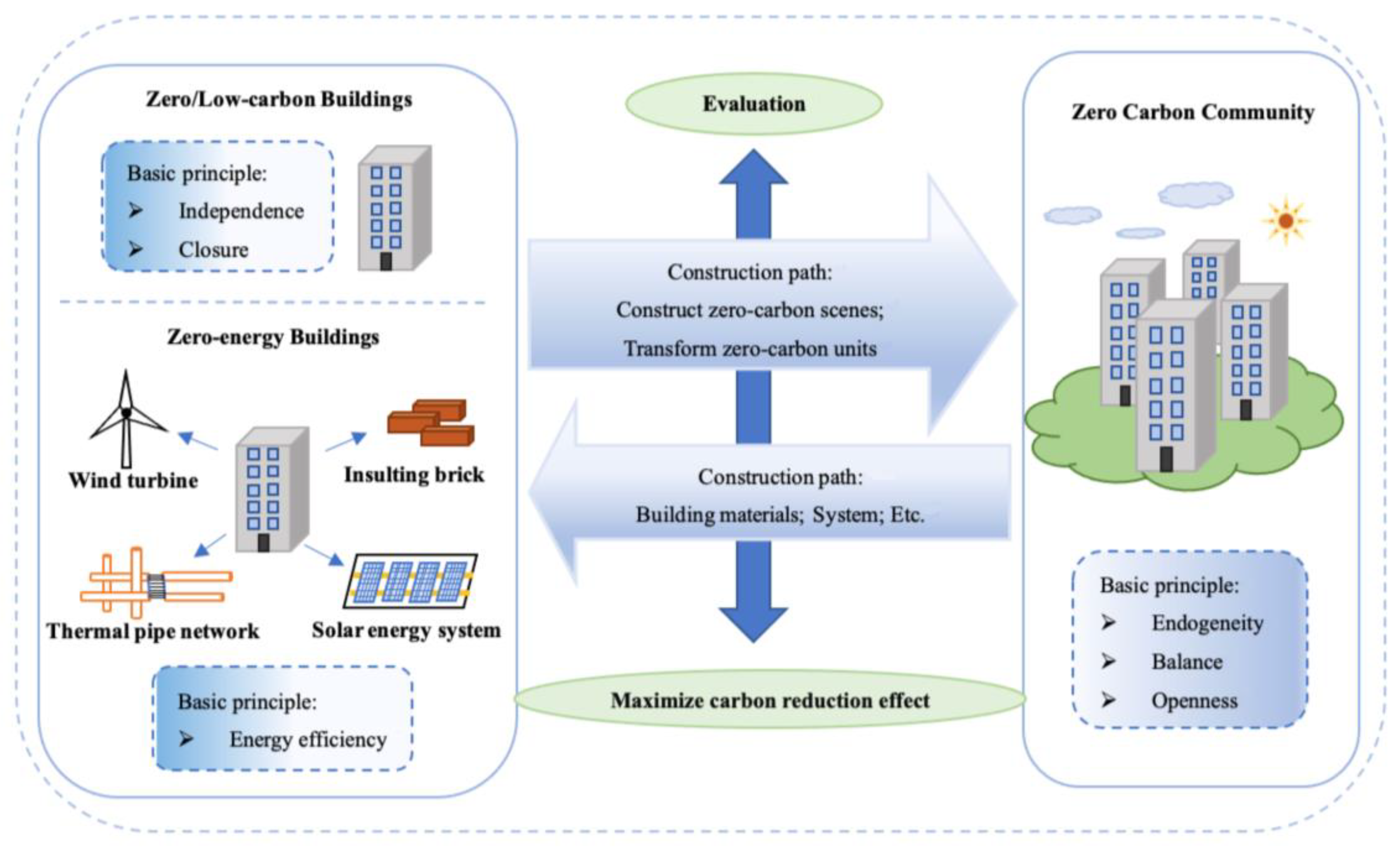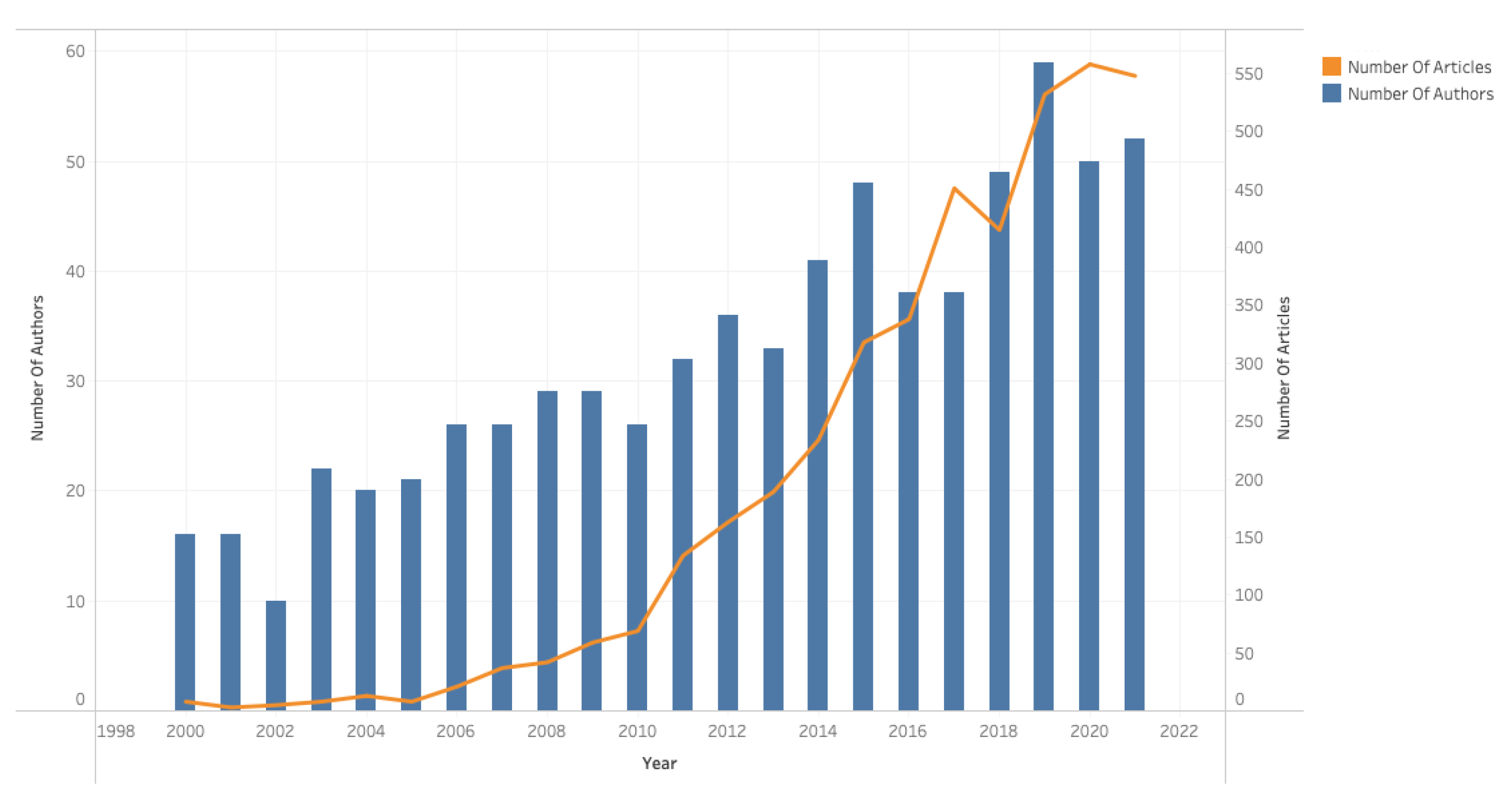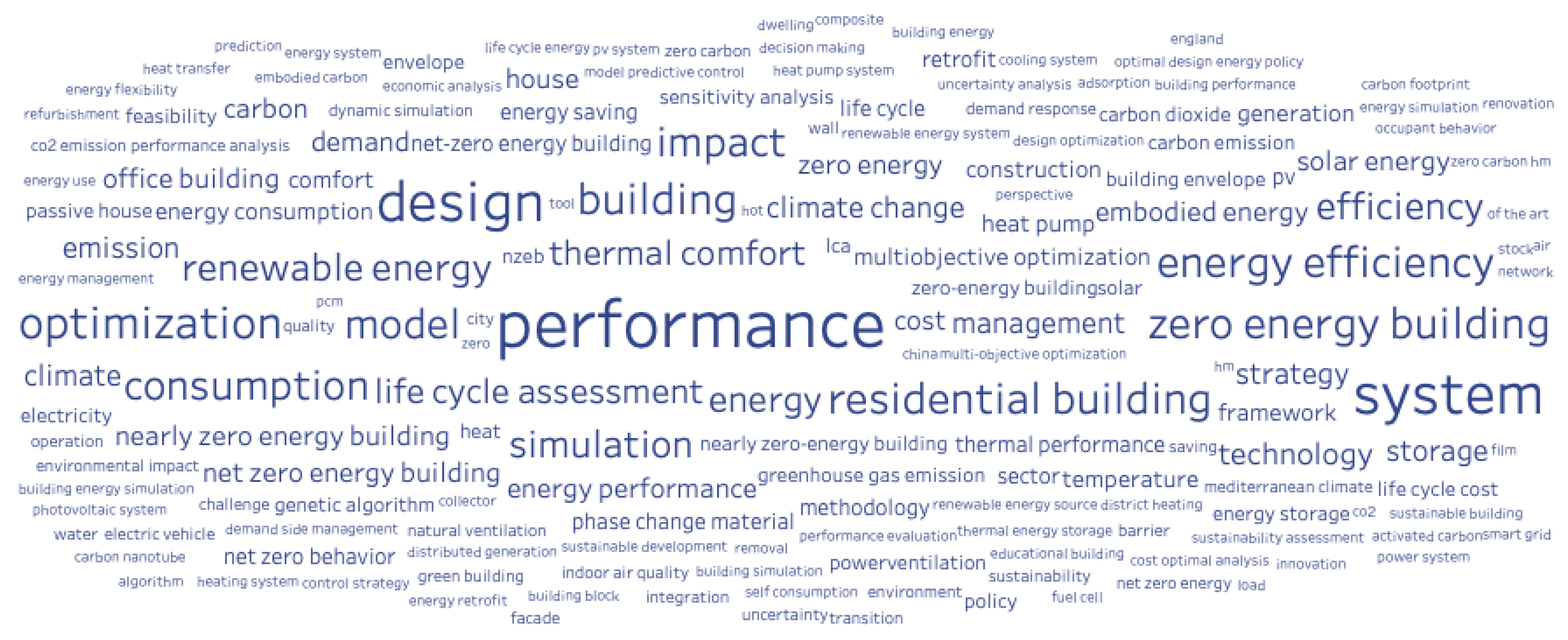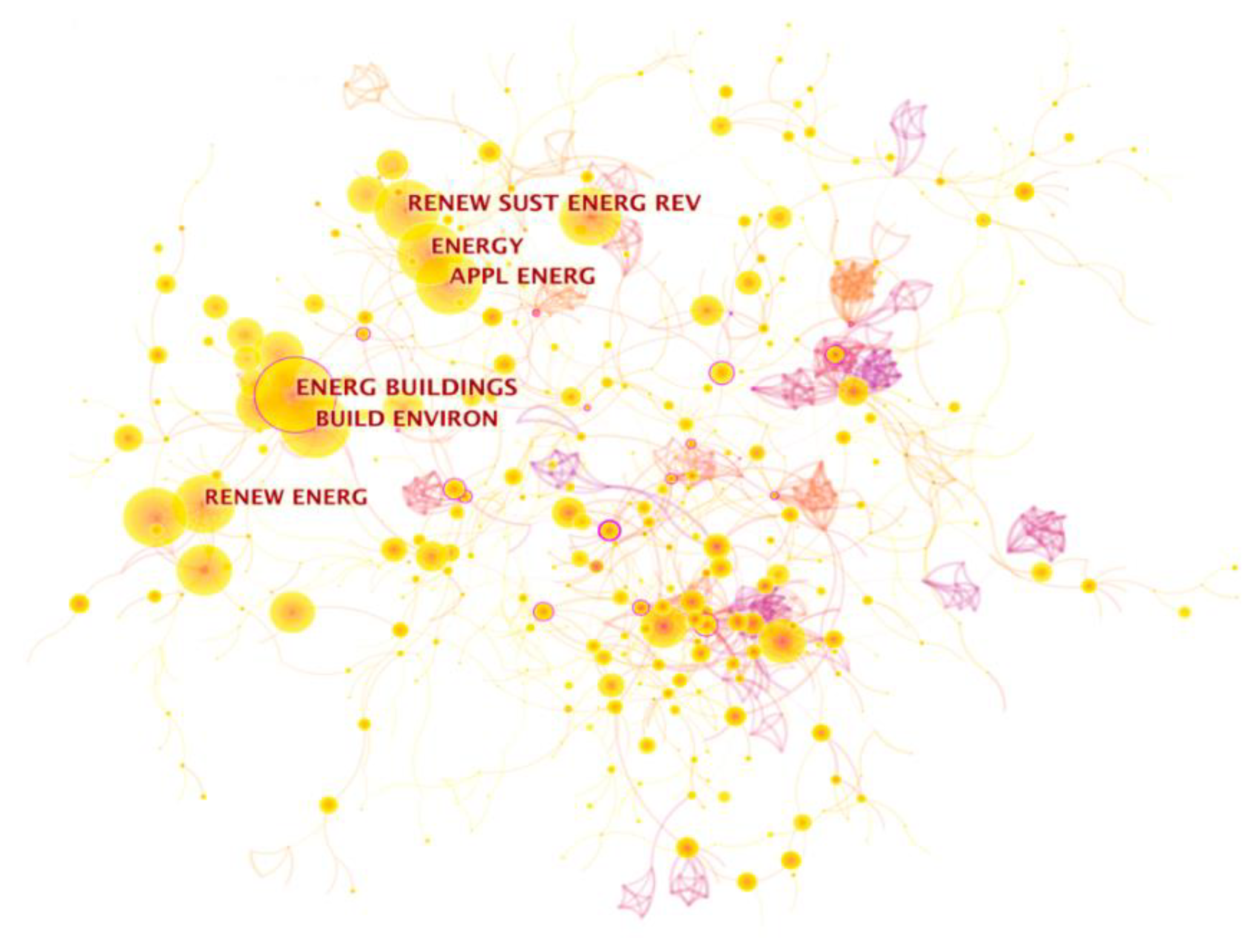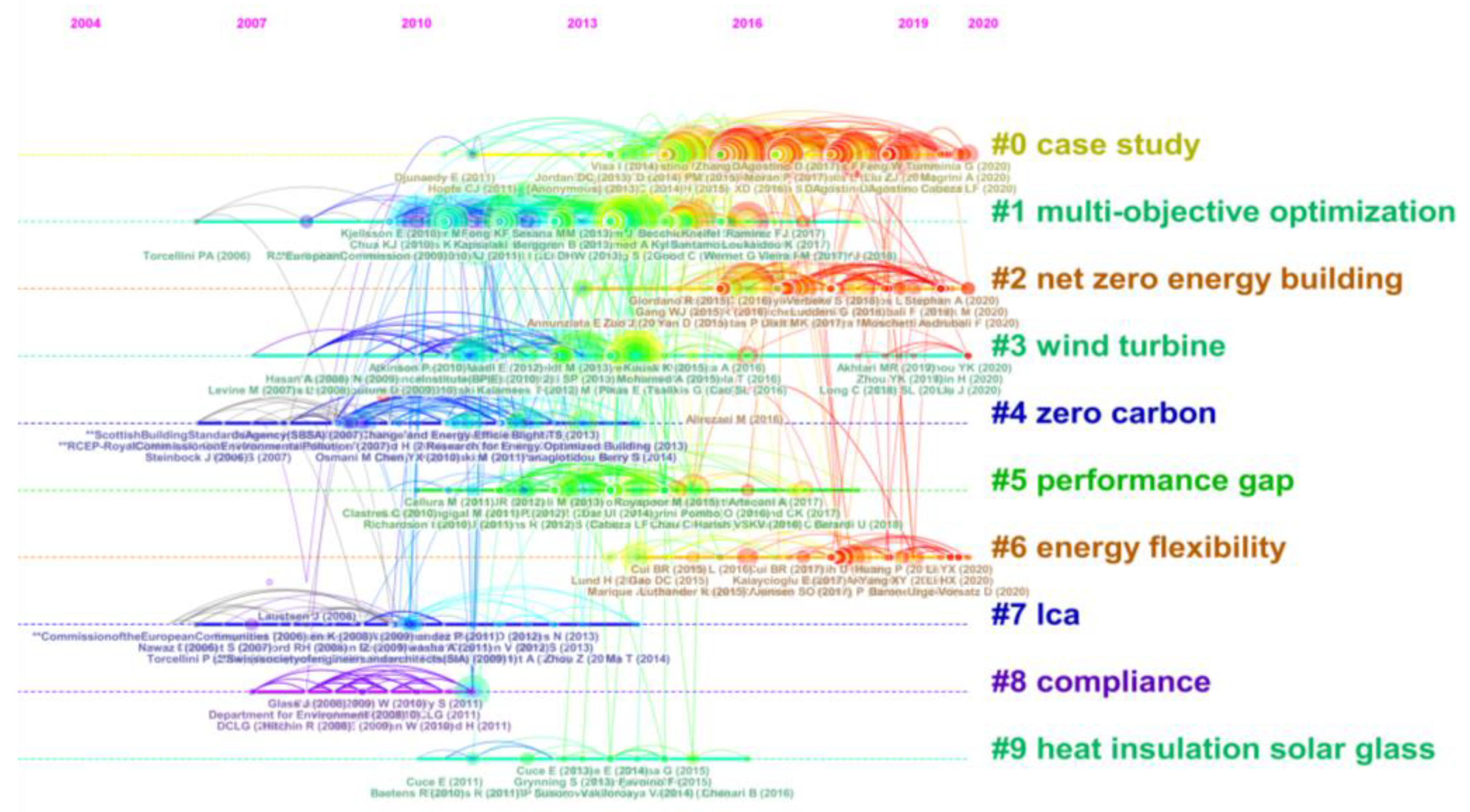3.3.1. The Evolution Trend of Keywords
When analyzing the frequency of keywords, we set the CiteSpace (5.8.R3 SE 64-bit) parameter settings as follows: Time span Period to 2021, the Time Slice as a Time partition every year, the analysis object as the keyword and the filtering criteria of the analysis object as the TOP50. The Pathfinder algorithm was used to trim the graph and run to obtain eight clusters of keywords, including energy storage, thermal comfort, life-cycle assessment, carbon dioxide levels, carbon nanotube, energy efficiency, PCM and climate change. Furthermore, this study used the cluster number as the Y-axis and the publication year as the X-axis, and finally obtained the time axis visualization of the keyword co-occurrence network (
Figure 4).
The brown mark “+” represents “burst”, which represents the keywords with the highest fluctuation frequency in a certain period, namely, the high-frequency keywords, which indicate the research trends. It should be noted that the frequency of high-frequency keywords is not completely uniform. That is, in general, the larger the shape of the brown marker “+”, the higher the frequency of high-frequency keywords at a certain time. Combining keywords with time can accurately reveal the research trend and research results within a certain period of time.
For instance, a number of important study findings in the area of carbon dioxide emissions were published between 2000 and 2007 with keywords such as climate, systems and climate change. The definition of a zero-energy building in its infancy only refers to the energy used in the building’s operation, ignoring the energy use aspects related to the building’s construction and delivery, as well as the energy use of the building’s components. In contrast, the concept of “net zero energy building”, which is used in the field of ecological economics, considers the energy used in the production of building materials and is widely used in fields such as agriculture and transportation. In addition, from
Figure 4, we can see that the keyword node of cluster #2 life-cycle assessment shows that, in 2006, the carbon emission levels of building stock in China began to be considered a problem. In 2011, a number of zero-energy buildings appeared in the field, and resarchers began to make a connection between the life-cycle of buildings and zero-energy buildings. From 2012 to 2021, the impact of the carbon footprint on the life-cycle of buildings was noticed, and further research has been conducted to develop zero-energy buildings.
The burst terms in
Figure 5 were paired with the aforementioned results to explore the boundaries and difficulties of zero-energy construction research. Words that are likely to change often over a short period of time are referred to as “Burst Terms” and may represent the direction of current scientific inquiry. CiteSpace can be used to find and display academic material of common interest as well as the frequency of citations over a specific time period by applying burst detection methods. Keywords will draw more attention in the time period under consideration the more sudden they are, which in some ways reflects the research frontier and hot area of an academic field. The time period for “Burst Terms” to occur is indicated in red in
Figure 5.
As can be seen from
Figure 5, carbon nanotube is the first keyword to be highly valued by scholars in the field of zero-energy building research and has received attention since 2004. Bent is the keyword that has received attention for the longest time in the field of zero-energy construction, attracting wide attention from researchers for 12 years, from 2005 to 2017. There is a close connection between carbon nanotube and bent. Carbon adsorption materials have become the most representative type of air purification materials due to their large specific surface area, stable physical and chemical properties, and strong adsorption performance. Carbon nanotubes have unique properties, such as special electrical conductivity, mechanical properties, and physical and chemical properties, and have attracted attention and been widely used in many scientific fields since their emergence. The issue of carbon emission reduction has been widely discussed since 2007 and continued to be a major source of concern throughout 2014. In 2018, we can see that researchers started to study and explore zero-energy buildings from the perspectives of heating system, power system, storage system and others, paying more attention to the exploration of technologies conducive to the realization of zero-energy buildings. This means that scholars have more specific research priorities.
3.3.2. Cluster and Evolution Trend of Co-Citation Network
In this section, CiteSpace (5.8.R3 SE 64-bit) software was used for the co-citation analysis. Firstly, we chose the node type “cited journal” and extracted the Top50 cited in each time slice. We selected “cosine” as the connection strength and used “Pathfinder + Pruning the Merged network” for the cluster analysis. The results are shown in
Figure 6. The color change in the co-citation network represents the distance in time. The warmer the color, the closer the time; the colder the color, the longer the time. Network clustering analysis can reveal changes in knowledge base topics in each stage, which is an important reference for this study.
The concept of literature co-citation was first proposed in 1973. Co-citation can be defined as the situation when both articles A and B are cited by article C at the same time. Therefore, we can say that there is a co-citation relationship between A and B. Co-citation analysis and visual measurement are common methods to study the spatial structure and relationship between different pieces of literature. The purpose of co-citation analysis is to distinguish high-impact journals in the field from authors who have made considerable contributions to the research topic, and to help scholars to quickly locate influential articles in the field. At the same time, it can reflect the connections between different journals and disciplines, and show the basic distribution of existing research in a certain field.
In order to show the co-cited journals in the field of zero-energy buildings more clearly, based on
Figure 6, this study selected the top 10 co-cited journals according to the principle of the center value from high to low and analyzed their country, impact factor and JCR partition. The results are shown in
Table 9. As can be seen from
Table 9, as a whole, British journals have a strong influence in the field of zero-energy buildings. The co-cited journals were listed as
Atmospheric Environment,
Nature and
Energy Policy by influence.
This study employed CiteSpace to depict the time axis of co-cited literature in order to further investigate the development trends of co-cited literature in the temporal dimension. The Top50 references in each time slice were extracted using the “cited reference” node type. We chose “cosine” as the link strength and performed a cluster analysis using “Pathfinder + Pruning Sliced Networks”. Finally, a co-citation network yielded 1107 nodes and 2471 connections (
Figure 7). The network’s clustering effect is good, its density is 0.004 and its modularity Q value is 0.8289. To achieve the timeline representation of the network of literature citations, we further used the Timeline view (
Figure 7).
The relationship between clusters and the chronological range of the literature within a cluster is mostly shown in the timeline view in
Figure 7. The timeline view allows for the analysis listed below: (1) The year that the cluster first appeared, or the year that the cluster’s initial reference point was found; (2) The year that the cluster’s achievement begins to rise; and (3) The year that the cluster’s growth begins to decline. (4) During the entire cluster formation process, key texts (such as widely cited works of literature and highly mediated texts, as revealed in
Table 10) and their effects on the overall cluster’s trend were taken into consideration. The evolution tendency of each cluster in the field of zero-energy buildings can be clearly seen through the above-detailed study of clusters and significant nodes in the co-citation network.
As can be seen from
Figure 7, 2011 is the key node of co-cited literature. Before 2011, the co-cited literature cluster mainly included clusters #7 and #8, when the zero-energy building research was still in its infancy. At this stage, the co-cited literature of researchers could be clustered into two categories, namely, #7 life-cycle assessment and #8 compliance. After 2011, compliance-related co-cited pieces of literature no longer appeared. On the contrary, co-citation studies based on the case study, multi-objective optimization, net-zero-energy building, wind turbine and other aspects show a diversified trend.
The definition, concept, calculation and viability of zero-energy buildings are primarily discussed and analyzed in the co-cited literature that was published before 2011, according to the literature’s network of co-citations, and these works have much in common with the highly cited works on the subject. According to the majority of academics, a zero-energy building should be outlined as one that has an output that is more than or equal to its input of energy [
23], also referred to as a self-sufficient building [
24]. By examining the energy calculation techniques used in nations with zero-energy buildings, researchers have calculated the energy performance level of buildings with the lowest cost and net-zero energy [
25]. Leckner [
26] showed the viability of using current solar technology to create at least as much energy as the primary energy needed by the residents year-round. According to Kolokotsa [
27], zero-energy structures have more stringent and complex performance standards in addition to being environmentally responsible and grid-friendly.
The co-citation network of the literature indicates that, after 2011, topics including case studies, multi-objective optimization, performance gap and energy flexibility have received an increasing amount of attention, and the topics that researchers are interested in have gradually assumed a more definite form. Three levels of the zero-energy building research process are shown in
Figure 8.
Scholars have studied the development status or problems of zero-energy buildings in different regions [
28]. Western countries developed zero-energy buildings earlier. Some scholars evaluated the implementation progress of an NZEB in Europe and compared the definitions of EU-NZEB and US-NZEB [
29]. TRNSYS (Transient System Simulation Program) dynamic energy simulation software and GenOpt general optimization program were used to find the optimal level of cost to reduce building energy consumption for single buildings in France [
30]. In contrast, the development of zero-energy buildings in Asia is relatively late and there are more problems. In Malaysia, there are barriers in cost, skill and technology and government policy in the development of zero-energy buildings [
31].
Some academics hold the opinion that, while assessing the implementation of zero-carbon buildings, multi-objective optimization should be used and that four indexes, namelym primary energy (PE), site energy, CO2 equivalent emission and energy cost, should be taken into account [
19]. Similar multi-criteria RES design optimization techniques were proposed by several researchers [
32], and they effectively supported an architectural design [
33]. They also used examples to examine the “zero-energy” buildings’ operational performance, emphasizing the significance of multi-objective optimization for zero-carbon structures [
34]. A building’s energy efficiency can be improved by determining the appropriate mix of design techniques [
35]. There is no precise way to accomplish or approach the net zero energy aim, however, in fully integrated buildings with complex interactions between energy production, consumption and storage systems and automatic and manual control systems/elements [
36].
The most fundamental technical aspects of attaining zero-energy buildings, as far as we can tell, are building materials, window size [
37] and orientation [
38], the possible window design scheme of office buildings [
39] and the importance of photosynthetic materials in zero-carbon buildings [
40]. Additionally, some researchers have demonstrated that photovoltaic systems, solar energy systems and their combination will significantly affect zero-carbon structures in terms of energy savings, grid interaction and financial considerations [
41]. Climate and energy targets, as well as decreasing costs, have led to the increased use of solar PV in residential buildings [
42], with the additional costs of zero-carbon buildings being mainly for the installation of PV systems [
43]. Additionally, there are issues with estimating non-dispatchable electrical energy consumption in zero-energy buildings [
44], and high insulation and large PV systems play a key role in the energy balance of near-zero and net-zero buildings [
22]. Some scholars pointed out that one of the most potential competitive solutions is based on potential energy efficiency measures and is sensitive to the energy storage system for energy consumption control [
45]. Only the family and active citizen who use a photovoltaic (PV) grid power system is responsible for participating in the solution of reducing carbon and energy challenges, in an attempt to achieve zero-carbon buildings [
46].
Finding the important literature was the subsequent step after examining the knowledge base and advancement of zero-energy buildings. We principally emphasized two aspects: (2) The similarity in the centrality node is high, and the references establish a co-citation link with many studies, having a relationship with many studies. (1) High-frequency nodes signify widely cited literature, which provides an essential knowledge base on a particular topic. These nodes serve as “transportation hubs”, which to some extent serve as research hotspots. The results are displayed in
Table 10.
A few significant studies can be found by analyzing the co-citation relationship with other studies, as shown in
Table 10. There are differences between article centrality and citation frequency. The frequency with which a node serves as a short-circuited bridge between the other two nodes is known as mediation centrality. A node’s mediation centrality will increase with the frequency of its “intermediary” roles. A larger mediating role is played by articles with a higher centrality in this field’s research process, which can more accurately reflect their influence. However, there is not a direct link between citation frequency and mediating centrality. The study with the most citations is that of Marszal [
11], which presented and discussed potential responses to the aforementioned problems while focusing on the majority of zero-energy building definitions in use at present and a variety of potential calculation methodologies. To encourage the development of a standard concept of zero-energy buildings and reliable energy calculation methodologies, Sartori [
6] presented a unified framework to determine the definition of net-zero-energy buildings. The definition of a zero-energy building was established systematically through the evaluation of standards and the selection of pertinent choices in the definition framework. Building energy design introduces the idea of grid interaction flexibility as an ideal objective. In the cross-comparison of the social and technological impediments to the implementation of net-zero-energy buildings in seven southern European nations, Attia [
21] compiled the findings and investigated and analyzed the current state of net-zero-energy buildings in Southern Europe. Due to a lack of adequate technical support for retrofitting older structures, the majority of southern European nations are not ready to execute the net-zero-energy building. Mohamed’s [
19] essay, which thoroughly examined the impact of several indicators on the achievement of zero-energy buildings under various definitions, had the greatest centrality. Through a review of the literature, Deng [
7] created a guide to the evaluation of net-zero-energy buildings, outlined the definition and energy-saving practices of zero-energy buildings, and made clear the purpose of the study and the technical limitations of zero-energy building evaluation.
